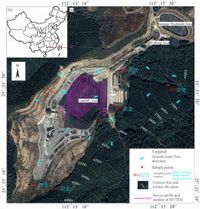In a revealing study published in Scientific Reports, researchers investigated leachate leakage from a valley-type landfill in South China and its significant implications for groundwater pollution and public health. The study, conducted by Yulong Lu and colleagues, sought to assess the environmental challenges posed by this landfill, which has been operational since 2014.
Landfills have become a pressing concern globally, particularly in developing nations witnessing rapid urban expansion. The leachate produced from landfills contains high concentrations of organic and inorganic materials, the infiltration of which poses a grave risk to local groundwater sources. This investigation focused on understanding how such contamination occurred and its potential health risks.
Utilizing geophysical detection methods, including the transient electromagnetic method, researchers identified four areas in the landfill’s impermeable layer that were compromised. These leakage zones spanned an area of 336.8 m2 with depths ranging from 15 to 22 meters, indicating a troubling sign of contamination escape from the landfilled waste to the surrounding aquifers.
The chemical analysis of groundwater, carried out in summer 2022, revealed alarming findings. Monitoring sites ZK01 and ZK04 exhibited heavy pollution, with the Nemerow pollution index (NPI) indicating severe levels surpassing Class III water quality limits. Notably, pollutants such as pH, ammonia nitrogen (NH3-N), manganese (Mn), and iron (Fe) were found to be significantly elevated in these areas, prompting concerns about the safety of drinking water drawn from these aquifers.
Researchers found that groundwater quality was markedly degraded at ZK01 and ZK04, reflecting an NPI greater than 3, which classifies these sites as severely polluted. In contrast, ZK02 and ZK03 showed slight pollution, whereas sampling point ZK05 displayed no signs of contamination.
The implications of these findings extend beyond environmental integrity to human health. Using numerical simulation based on the Risk-based Corrective Action (RBCA) model, the study predicted that concentrations of Mn and NO3-N posed non-carcinogenic risks to human health. Expected increases in the hazard index (HI) for these pollutants suggested that if no remedial measures were instituted, the average HI would rise between 0.04 and 0.08 per annum, with the risk area potentially expanding by 341 to 432 m2 each year. Moreover, along the groundwater flow path, the expansion rates of the risk area were assessed at 1.6 to 3.8 m annually.
Health risk assessments characterizing Mn and NO3-N indicated significant cause for concern, especially for communities relying on local groundwater sources for drinking water. The study emphasized the imperative for implementing monitoring systems and hazard prevention strategies to safeguard public health.
This comprehensive examination not only elucidates the challenges posed by leachate pollution from landfills but highlights the critical need for effective waste management practices and immediate action to mitigate health risks. With the growing volume of domestic waste, especially in fast-developing regions, proactive measures are essential to protect groundwater as a vital resource.
In conclusion, the findings from this study underscore the importance of ongoing research and monitoring in managing the adverse effects of landfill leachate. Addressing this issue is crucial not only for environmental protection but also for ensuring the health and safety of communities relying on these groundwater sources.

